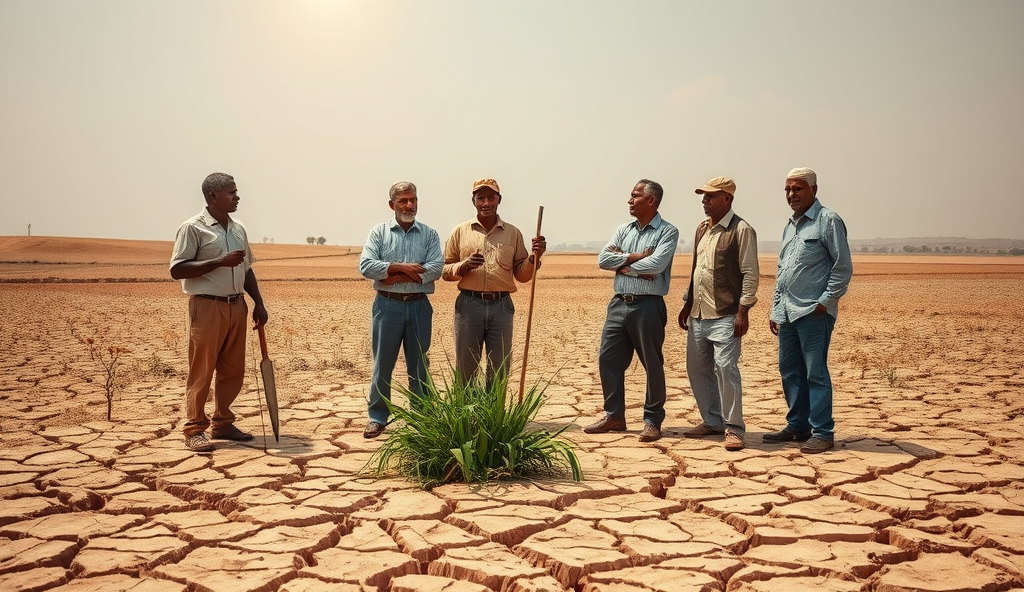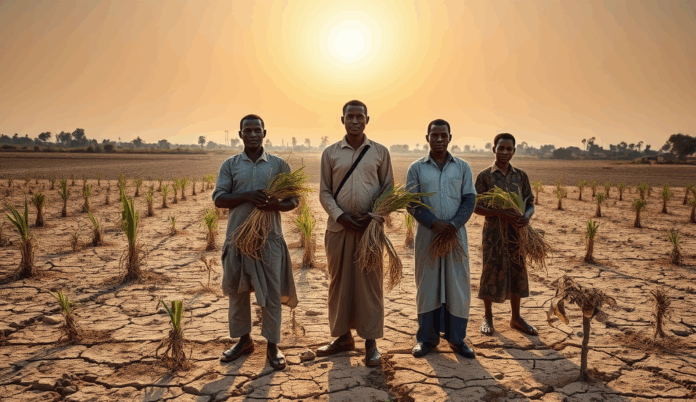Introduction to Crop Failure in Nigeria
Crop failure in Nigeria has become a pressing issue, with over 30% of farmlands experiencing significant yield losses annually due to multiple factors. Farmers across regions like the North-East and Middle Belt face recurring agricultural droughts and unpredictable rainfall patterns, severely impacting staple crops such as maize, rice, and cassava.
Soil degradation and pest infestations further exacerbate the problem, with Fall Armyworm alone destroying 40% of maize crops in 2022. These challenges contribute to food insecurity and economic losses, pushing many smallholder farmers into poverty cycles.
As we explore these issues deeper, climate change emerges as a critical driver of these farming crises, altering traditional growing seasons and rainfall distribution. The next section will examine how unpredictable weather patterns intensify crop failure risks across Nigeria’s diverse agro-ecological zones.
Key Statistics

Climate Change and Unpredictable Weather Patterns
Crop failure in Nigeria has become a pressing issue with over 30% of farmlands experiencing significant yield losses annually due to multiple factors.
Nigeria’s rainfall patterns have shifted dramatically, with the rainy season now starting up to six weeks later in northern states like Kano and Katsina, disrupting planting cycles for maize and sorghum. The 2021 floods in Benue State submerged over 100,000 hectares of farmland, wiping out entire yam and rice harvests while displacing thousands of farming families.
Rising temperatures have increased evaporation rates by 15% in the Lake Chad basin, shrinking water sources critical for irrigation in Borno and Yobe states where drought-resistant millet varieties now struggle to thrive. A 2023 study by the Nigerian Meteorological Agency revealed that 60% of farmers in the Middle Belt can no longer predict rainfall accurately using traditional methods.
These erratic conditions compound existing challenges like soil degradation, which we’ll explore next, as farmers face both water scarcity during dry spells and nutrient leaching during intense downpours. The resulting crop failures have pushed Nigeria’s food inflation to 31% in 2023, with staple prices becoming increasingly unaffordable for rural communities.
Poor Soil Quality and Degradation
Nigeria’s rainfall patterns have shifted dramatically with the rainy season now starting up to six weeks later in northern states like Kano and Katsina disrupting planting cycles for maize and sorghum.
Compounding erratic rainfall patterns, Nigeria’s farmland suffers from severe soil degradation, with 75% of arable land in the North losing fertility due to unsustainable farming practices like continuous monocropping of maize and sorghum. The FAO reports that nutrient depletion rates in states like Kaduna and Sokoto exceed 60kg per hectare annually, forcing farmers to expand into marginal lands.
Intense downpours, as seen during the 2021 Benue floods, accelerate topsoil erosion, washing away vital nutrients while prolonged droughts in the Lake Chad basin leave soils compacted and barren. A 2022 soil study in Niger State revealed a 40% drop in organic matter compared to pre-2000 levels, drastically reducing yields for staples like yam and millet.
These depleted soils demand more fertilizers—a challenge for smallholders already struggling with rising input costs—setting the stage for our next discussion on seed accessibility. Without intervention, Nigeria risks losing another 30% of productive land by 2030, worsening food inflation currently at 31%.
Inadequate Access to Quality Seeds and Inputs
Nigeria’s farmland suffers from severe soil degradation with 75% of arable land in the North losing fertility due to unsustainable farming practices like continuous monocropping of maize and sorghum.
Nigeria’s farmers face a dual crisis as depleted soils demand high-quality seeds, yet only 20% have access to certified varieties, according to the National Agricultural Seeds Council. Many rely on saved seeds from previous harvests, which often have low germination rates and carry diseases, further reducing yields in already stressed farmlands.
The rising cost of hybrid seeds and fertilizers—up 45% since 2020—forces smallholders in states like Kano and Adamawa to use substandard inputs, worsening crop failure risks. A 2023 IITA study found that poor seed quality alone reduces maize productivity by 30%, compounding losses from soil degradation discussed earlier.
These challenges create a vicious cycle: weak harvests limit farmers’ ability to reinvest in quality inputs, making crops more vulnerable to pests and diseases—a problem we’ll explore next. Without systemic solutions, Nigeria’s seed deficit could cut annual grain production by 15 million metric tons by 2025.
Pests and Diseases Affecting Crops
The rising cost of hybrid seeds and fertilizers—up 45% since 2020—forces smallholders in states like Kano and Adamawa to use substandard inputs worsening crop failure risks.
The weakened crops resulting from poor seed quality and degraded soils become easy targets for pests like fall armyworms, which destroyed over 400,000 hectares of maize in Nigeria’s northern states in 2022, according to CABI. Stored grain pests like weevils further reduce harvests by 15-20%, compounding losses from field infestations.
Diseases such as cassava mosaic virus and maize lethal necrosis thrive in stressed farmlands, with the Nigerian Institute of Agricultural Research reporting 40% yield drops in infected fields. Farmers using contaminated saved seeds, as mentioned earlier, inadvertently spread these pathogens across generations of crops.
Without proper pest management techniques—often inaccessible due to high costs—farmers resort to ineffective homemade remedies, setting the stage for our next discussion on modern farming gaps. These unchecked infestations erode profits, leaving fewer resources for critical investments in better practices.
Limited Access to Modern Farming Techniques
Addressing crop failure in Nigeria requires a multi-faceted approach combining climate-smart agriculture with improved access to drought-resistant crops and better pest management strategies.
The financial strain from recurring pest losses, as highlighted earlier, leaves many Nigerian farmers unable to adopt precision agriculture tools like soil sensors or GPS-guided planters, which could boost yields by 20-30% according to FAO studies. In Katsina State, only 12% of smallholder farmers use improved mechanization, perpetuating reliance on labor-intensive methods that limit productivity.
High costs and poor rural infrastructure block access to climate-smart technologies like drought-resistant seeds or moisture-conserving techniques, worsening vulnerability to erratic rainfall patterns—a challenge we’ll explore next. Training gaps also persist, with the National Agricultural Extension Services reaching just 40% of farmers, leaving many unaware of innovations like integrated pest management or crop rotation systems.
This technological deficit forces farmers into cycles of low productivity, exacerbating food insecurity caused by farming challenges while limiting adaptation to soil degradation and climate change effects. The next section examines how insufficient irrigation systems further compound these pressures during dry spells.
Insufficient Irrigation Systems
Compounding the challenges of erratic rainfall patterns, only 4% of Nigeria’s arable land has irrigation coverage, leaving farmers dependent on increasingly unreliable seasonal rains. In northern states like Jigawa, prolonged dry spells reduce maize yields by up to 50%, forcing farmers to abandon fields despite available groundwater resources.
High diesel costs and inadequate infrastructure limit access to motorized pumps, with 78% of smallholders relying on manual watering methods that waste water and labor. The World Bank estimates Nigeria loses $1.5 billion annually in unrealized crop production due to poor irrigation, worsening food insecurity caused by farming challenges.
These systemic gaps push farmers deeper into poverty cycles, setting the stage for the economic challenges and lack of funding that hinder large-scale irrigation investments—a barrier we’ll analyze next.
Economic Challenges and Lack of Funding
The $1.5 billion annual loss from poor irrigation highlights how economic constraints trap Nigerian farmers in low-productivity cycles, with 62% unable to access credit for irrigation equipment. Banks perceive smallholder farming as high-risk, charging interest rates up to 30% that deter investments in water pumps or modern systems.
State-led irrigation projects like the Bakolori Dam in Zamfara remain underfunded, with only 12% of planned schemes operational due to budget shortfalls and mismanagement. This funding gap forces farmers to rely on costly diesel pumps, spending 40% of profits on fuel alone during dry seasons.
Without financial interventions, these economic losses will persist, underscoring the need for targeted government policies to unlock agricultural financing—a solution we’ll explore next.
Government Policies and Agricultural Support
Recent initiatives like the National Agricultural Growth Scheme (NAGS) aim to bridge Nigeria’s irrigation financing gap, offering 50% subsidies on water pumps to 250,000 smallholder farmers. However, implementation delays persist, with only 18% of targeted beneficiaries receiving support as of 2023 due to bureaucratic bottlenecks and uneven state-level execution.
The Anchor Borrowers’ Programme has disbursed ₦1.08 trillion since 2015, yet repayment challenges and middlemen exploitation limit its impact on crop failure reduction. States like Kebbi show success with 72% loan recovery rates, but nationwide adoption requires stricter monitoring and farmer education on climate-smart practices.
These interventions must scale strategically to address interconnected challenges—from diesel pump dependency to soil degradation—setting the stage for systemic solutions we’ll examine in closing.
Conclusion on Addressing Crop Failure in Nigeria
Addressing crop failure in Nigeria requires a multi-faceted approach, combining climate-smart agriculture with improved access to drought-resistant crops and better pest management strategies. For instance, adopting maize varieties like SAMMAZ 52, which yield 30% more under drought conditions, can significantly reduce harvest losses.
Government interventions must prioritize soil health through subsidies for organic fertilizers and training on sustainable farming practices. States like Kebbi have seen success with irrigation projects, boosting rice production by 40% despite erratic rainfall patterns.
Farmers must also leverage local cooperatives to share resources and knowledge, creating resilience against climate change effects on Nigerian agriculture. Collaborative efforts between researchers, policymakers, and farming communities will be key to ensuring food security in the coming decades.
Frequently Asked Questions
How can I protect my maize crops from fall armyworms without expensive pesticides?
Use neem leaf extract as a natural pesticide and practice intercropping with repellent plants like marigold to reduce infestation.
What affordable irrigation methods can I use during dry spells?
Try drip irrigation using recycled bottles or adopt the 'zai pit' technique to conserve water and target plant roots directly.
Where can I access drought-resistant seeds like SAMMAZ 52 in northern Nigeria?
Contact your state’s Agricultural Development Project (ADP) office or local farmer cooperatives for subsidized seed distribution programs.
How do I improve my degraded soil without buying chemical fertilizers?
Apply compost made from farm waste and practice crop rotation with legumes like cowpea to naturally replenish soil nutrients.
Can I get government support for irrigation equipment under the NAGS program?
Visit your local agriculture extension office with proof of farmland ownership to apply for the 50% water pump subsidy.


